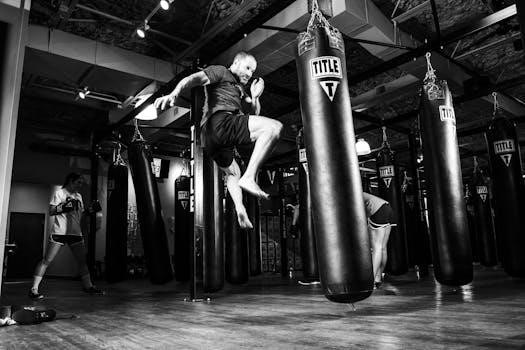12-week boxing programs are structured to prepare fighters for peak performance. These programs often employ periodization, with phases designed to progressively build strength, speed, and endurance. They include deload weeks to prevent overtraining and optimize results. The goal is to create well-rounded boxers.
Overview of 12-Week Boxing Training
A 12-week boxing training program is a comprehensive plan designed to transform an individual into a more proficient and powerful boxer. These programs are carefully structured, often employing a periodized approach. This means they are divided into distinct phases, each with specific goals, such as building a solid foundation of strength, enhancing speed and power, and improving cardiovascular endurance. The typical weekly schedule includes dedicated days for technique drills, sparring, strength and conditioning workouts, and cardio sessions. Deload weeks are strategically placed to allow for recovery and prevent overtraining, ensuring the athlete can progress effectively throughout the program. The ultimate objective is to achieve peak physical condition and optimal boxing skills by the end of the 12 weeks. These programs are suitable for both beginners and advanced fighters, with adjustments made to cater to different fitness levels and goals. The focus is always on progressive overload, ensuring continuous improvement.

Program Structure and Periodization
A 12-week boxing program is typically divided into phases, each building upon the previous one. Periodization ensures that training intensity and volume are systematically adjusted to optimize performance and prevent injury.
Phases of a 12-Week Program
A typical 12-week boxing program is structured into distinct phases, each with specific goals. Often, the initial phases focus on building a solid foundation, emphasizing joint integrity and muscle hypertrophy. This involves lower intensity, higher volume work to prepare the body for more intense training. As the program progresses, phases shift towards enhancing strength and power through targeted weight training and plyometrics. The final phase concentrates on peaking, incorporating more sparring and high-intensity interval training to prepare the boxer for competition. This periodization approach helps maximize results while minimizing the risk of overtraining.
Weekly Progression and Deloads
Weekly progression is a critical aspect of a 12-week boxing program. Each week builds upon the previous one, gradually increasing the intensity, volume, or complexity of training. This might involve adding reps, sets, or weight in strength training, or increasing the duration or intensity of cardio sessions. Deload weeks are strategically placed throughout the program to allow for recovery and prevent overtraining. These weeks typically involve a reduction in training volume and intensity, allowing the body to repair and adapt. Proper planning of weekly progression and deloads ensures continuous improvement without plateauing or risking injury.

Key Components of Training
Effective boxing training involves technique drills, sparring, strength and conditioning, and cardio. These elements combined will enhance a boxer’s power, speed, endurance, and overall performance in the ring.
Technique Drills and Sparring
Technique drills are fundamental to a boxer’s development, focusing on precise execution of punches like jabs, crosses, hooks, and uppercuts. These drills often involve shadow boxing, bag work, and pad work, emphasizing proper form and footwork. Sparring, a controlled form of simulated combat, allows boxers to apply their techniques against a live opponent. It helps refine timing, distance management, and defensive skills while building confidence in a dynamic setting. Consistent practice of both drills and sparring is essential for boxing mastery. These are typically combined into one training session with specific drills and then sparring sessions that increase in intensity and duration over the 12-week program. The emphasis on technique in these sessions helps develop heavy hands and quick reactions.
Strength and Conditioning Workouts
Strength and conditioning workouts are vital components of a 12-week boxing program, focusing on exercises directly applicable to boxing movements. These workouts include compound lifts like squats, deadlifts, and presses to build overall strength and power. Plyometric exercises, such as box jumps and medicine ball slams, enhance explosive power essential for impactful punches. Core work is crucial for stability and power generation, incorporating exercises like Russian twists and planks. The goal is to improve not just strength but also agility, speed, and muscular endurance. These sessions are carefully structured to complement the boxing technique training and avoid over-fatigue, ensuring the boxer is always prepared for their next training session. Proper technique is key to safe and effective training.
Cardio and Endurance Training
Cardio and endurance training are essential for boxers within a 12-week program, focusing on building the stamina required for multiple rounds in the ring. This training involves various methods, including running, interval sprints, and shadow boxing. High-intensity interval training (HIIT) is often incorporated to improve both aerobic and anaerobic capacity. Activities such as skipping rope, treadmill sprints, and Versa-climber sessions enhance cardiovascular health. Long-distance runs are also included in some programs to build a solid aerobic base. These workouts aim to improve the boxer’s ability to maintain a high level of performance throughout the match. The goal is to ensure that the boxer can sustain their energy and power output for the duration of each round without fatigue, crucial for both training and competition.

Sample Exercises and Workouts
A 12-week boxing program includes plyometrics for power, such as box jumps, and weight training with exercises like squats and presses. Conditioning involves shadow boxing and interval training; Core work is also included.
Plyometric Exercises for Power
Plyometric exercises are crucial for developing explosive power in boxing, enhancing both punch speed and overall agility. Box jumps, incorporating variations like 12-15 inch box jumps, and progressively increasing height each week, are a great way to build lower body power. Drop jumps are another effective option for developing explosive leg strength and improving reactive ability. It’s very important to ensure proper form and controlled movements to maximize the benefits and reduce the risk of injury. These exercises should be performed with a focus on fast concentric movements to translate directly to powerful punches. Incorporating plyometrics into a 12-week boxing program helps boxers become more dynamic and powerful in the ring. Proper rest and recovery are essential when performing these exercises.
Weight Training for Boxing
Weight training for boxing should prioritize movements that translate to improved punching power and overall strength, rather than simply building bulk. Focus on compound exercises like front squats and push presses, which engage multiple muscle groups. Exercises such as Bulgarian split squats and landmine Russian twists can help with core stability and rotational power. It’s important to use explosive movements during training sessions. Furthermore, it’s vital to avoid overtraining and to focus on technique over volume. Incorporating exercises like reverse hypers and ball hamstring curls can help strengthen areas that are often neglected. A balanced approach to weight training will ultimately enhance a boxer’s performance in the ring. Remember that proper form is essential to prevent injuries, and that consistency is a key factor.

Nutrition and Recovery
Proper nutrition is vital for combat sports, providing energy and supporting muscle repair. Recovery strategies, like adequate sleep and stretching, are crucial for preventing injuries and optimizing performance throughout the training program.
Importance of Nutrition for Combat Sports
In combat sports, nutrition plays a pivotal role, far beyond just fueling workouts. It’s the foundation for optimal performance, enabling boxers to train harder, recover faster, and maintain peak condition. A well-structured nutritional plan provides the necessary energy for intense training sessions and sparring, while also aiding in muscle repair and growth. Proper hydration is crucial for preventing fatigue and maintaining cognitive function. The right balance of macronutrients – carbohydrates, proteins, and fats – supports the demands of boxing, influencing everything from power and speed to stamina and focus. Furthermore, targeted nutrient intake can help manage weight effectively and promote overall health. Ignoring nutrition can lead to decreased performance, increased risk of injury, and delayed recovery times, ultimately hindering a boxer’s progress in the 12-week program and beyond. Therefore, a carefully crafted nutritional strategy is essential for maximizing training benefits and achieving success in the ring.
Recovery Strategies
Effective recovery strategies are paramount in a demanding 12-week boxing training program. Adequate rest and sleep are fundamental, allowing the body to repair and rebuild muscle tissue damaged during intense workouts. Active recovery, such as light cardio or stretching, can improve blood flow and reduce muscle stiffness. Proper hydration and nutrition are essential for replenishing glycogen stores and aiding muscle recovery. Techniques like foam rolling and massage can alleviate muscle soreness and improve flexibility. Strategic deload weeks, incorporated into the training program, provide crucial periods for the body to fully recover, minimizing the risk of overtraining and injury. Furthermore, mental recovery is equally important; engaging in relaxation techniques or mindfulness can help reduce stress and promote overall well-being. Ignoring recovery can lead to plateaus, increased risk of injury, and burnout. Therefore, a comprehensive approach to recovery is crucial for sustained progress and optimal performance throughout the 12-week training program and beyond, ensuring that the boxer remains fresh and ready for each training session.

Be First to Comment